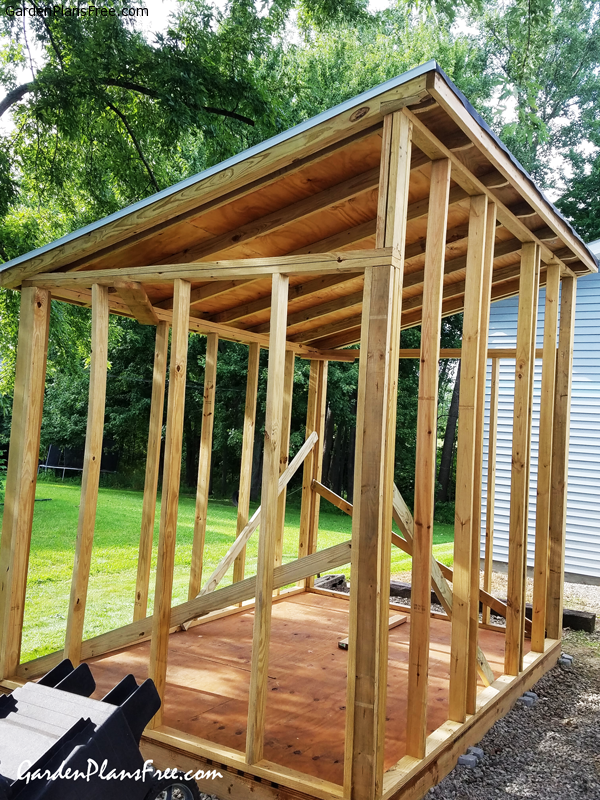
Alright, let's build a lean-to shed! I'm gonna talk you through it like we're sitting on a porch swing, sipping lemonade, and just chatting about building this thing. No fancy jargon, just good ol' fashioned DIY.
First things first, you need a plan. Not like a super detailed blueprint, but more like a mental picture. How big do you want this shed to be? How high do you want the walls? What kind of materials are you working with? You know, the basics.
Now, let's talk tools. You're gonna need the basics: a hammer, a tape measure, a level, a saw, a drill, and some screws. For cutting lumber, a circular saw is handy, but if you don't have one, a hand saw will do just fine. You might also want a shovel for digging the post holes (we'll get to that later).
Next up, materials. This is where you get to make some choices. For the frame, you can use pressure-treated lumber, which is resistant to rot and bugs. You can also use regular lumber, but you'll want to treat it with a wood preservative before you start building. For the roof, you'll need plywood, roofing felt, and shingles.
Now, let's get to the actual building part.
Step 1: Decide on Your Location
Think about where you want your shed to be. Is it going to be in the backyard? Up against the house? Make sure it's on level ground, or you're gonna have a lopsided shed, and nobody wants that.
Step 2: Dig Your Post Holes
You'll need to dig holes for the posts that will support the roof. If you're building a small shed, two posts will do the trick. If you want a bigger shed, you'll need more posts, maybe even three or four. The posts should be at least 2-3 feet deep, depending on your local soil conditions.
Step 3: Set the Posts
Once you have your holes dug, it's time to set the posts. Now, remember, this is a lean-to, so one wall is going to be attached to your house or another existing structure. If you are setting up a free-standing lean-to, you will need to set a post at the front and a post at the back.
Step 4: Framing the Walls
Now, let's build the walls. If you're attaching your shed to an existing structure, you'll only need to frame one side. This is a good time to remember what size you decided on in your initial plan. You'll want to measure and cut your lumber to the appropriate lengths, so you have straight walls.
Step 5: Putting the Roof Together
Here's where things start to take shape. The roof is gonna be the most important part of your shed. Start by cutting the rafters (the angled beams that support the roof) to the desired length. You want them to be long enough to extend beyond the walls, creating a bit of overhang for protection. You can measure this out by creating a triangle from your wall to the post on the opposite end, and then add some extra length to the top (the rafters) to make the overhang.
Step 6: Sheathing the Roof
Now you're gonna take your plywood and cut it to the size of the roof. Then you'll attach it to the rafters, creating a solid surface for your shingles.
Step 7: Adding the Roofing Felt
Think of this as a protective layer for your shingles. You'll need to cut and staple the roofing felt down on top of the plywood sheathing. This will prevent water from seeping in and causing damage.
Step 8: Shingling the Roof
Alright, we're almost done! Start at the bottom of the roof and work your way up. The shingles will overlap each other, creating a watertight seal.
Step 9: Finishing Touches
Now, you can add a door, some windows, and a floor if you want. You can also paint the shed, or stain it to give it a nice finish.
There you have it, folks. A lean-to shed built from scratch! It's not rocket science, but it does require a little bit of effort. Just take your time, follow these steps, and you'll be well on your way to having a fantastic new storage space.
Safety First
Always remember to prioritize safety while building. Use safety glasses when working with power tools, and be sure to wear sturdy shoes. If you're unsure about anything, consult a professional.
Extra Tips
If you want a more durable roof, use metal roofing instead of shingles.
If you want a more rustic look, use reclaimed wood for the framing and siding.
Be sure to secure the shed to the ground with anchors or straps to prevent it from blowing away in strong winds.
Consider adding a vent to the roof to prevent moisture buildup inside the shed.
Don't Forget the Fun Part!
This is your shed, make it your own! Add some personal touches, maybe even some decorations. It's a chance to express yourself and create a unique space.
Happy building!
No comments:
Post a Comment